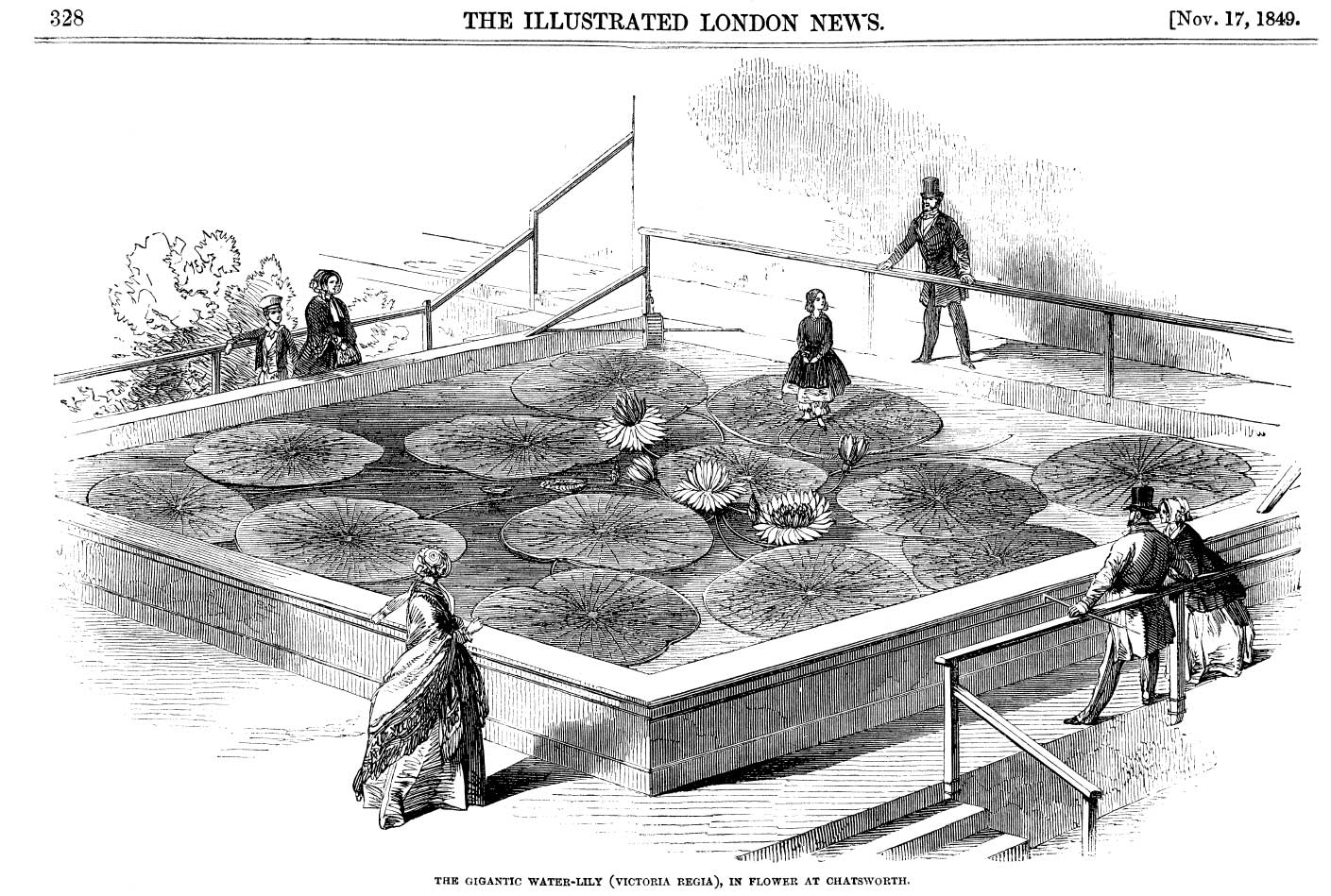- Victoria amazonica
Taxobox

image_width = 240px
image_caption = Illustration byWalter Fitch
regnum =Plant ae
divisio = Magnoliophyta
classis =Magnoliopsida
ordo =Nymphaeales
familia =Nymphaeaceae
genus = "Victoria"
species = "V. amazonica"
binomial = "Victoria amazonica"
binomial_authority = Sowerby "Victoria amazonica" is a species of flowering plant, the largest of theNymphaeaceae family of water lilies.The species has very large leaves, up to 3 m in diameter, that float on the water's surface on a submerged stalk, 7–8 m in length. The species was once called "Victoria regia" after Queen Victoria, but the name was superseded."V. amazonica" is native to the shallow waters of the
Amazon River basin, such as oxbow lakes and bayous. It is depicted in the Guyanese s.History
left|thumb|250px">
"On unbent leaf in fairy guise,
Reflected in the water,
Beloved, admired by hearts and eyes,
Stands Annie, Paxton's daughter..."
"Victoria regia", as it was named, was once the subject of rivalry between Victorian gardeners in England. Always on the look out for a spectacular new species with which to impress their peers, Victorian "Gardeners" [In reality they did little or no actual gardening at all, but employed talented horticulturalists such as Joseph Paxton (for Devonshire) and the forgetten Mr Ivison (for Northumberland) to run their estates and gardens.] such as theDuke of Devonshire , and theDuke of Northumberland started a well-mannered competition to become the first to cultivate and bring to flower this enormous lily. In the end, the two aforementioned Dukes became the first to achieve this,Joseph Paxton (for the Duke of Devonshire) being the first in November1849 by replicating the lily's warm swampy habitat (not easy in winter in England with only coal-fired boilers for heating), and a "Mr Ivison" the second and more constantly successful (for Northumberland) atSyon House .The Duke of Devonshire presented Queen Victoria with one of the first of these flowers, and named it in her honour. The lily, with ribbed undersurface and leaves veining "like transverse girders and supports", was Paxton's inspiration for
The Crystal Palace , a building four times the size of St. Peter's inRome . [H. Peter Loewer. "The Evening Garden: Flowers and Fragrance from Dusk Till Dawn". Timber Press, 2002. ISBN 0-88192-532-2. Page 130.]Image gallery
Brazil's legend
Legend has it that, a long time ago, the Tupis-Guaranis,
indigenous people from Northern Brazil, told that every night, when the moon hid behind the hills far off on the horizon, it was going to live together with its favorite young ladies. They used to say that, if the moon could like one single girl, it would transform her into a star of the sky.One princess,
Pajé 's daughter (Pajé being a significant figure of the indigenous people), was impressed with that story. So, at night, when everybody was sleeping and the moon was traveling across the sky, the princess wanted to be a star, so she walked up to the hills and chased the moon, hoping the moon could see her up in the hills.And so she did, every night, for a very long time.
But the moon did not seem to notice her, even though the crying of the princess could be heard in the distance as well as her sadness and sighs.
One night, the princess saw, in the clear waters of a lake, the image of the moon. The innocent girl wondered if the moon had come down to take her away, so she jumped in the deep waters to join the moon and its lovely young ladies. She was never seen again.
The moon, in return for the beautiful princess's sacrifice, transformed her into a different star, different from the all the others whose light lit up the night sky. So, the moon transformed the princess into a "Star of the Waters", whose flower is the "Vitória Régia".
At that moment, a new plant was born, whose scented white flowers blossom and unfurl only at night. And, when the sun appears in the early morning, the flowers change their color to soft pink.
References
* [http://www.geocities.com/Athens/Thebes/3544/vitoriaregia.html Victoria amazonica legend]
* [http://www.sumauma.net/amazonian/legends/legends-regia.html Victoria amazonica]
* [http://www.amazon-indians.org/page21.html About Victoria amazonica legend]External links
* [http://www.victoria-adventure.org/victoria/victoria_index.html "Victoria Adventure" - A website dedicated to this lily]
* [http://www.victoria-adventure.org/victoria/mike/gardeners_chronicle_pm.html An Article from the Gardener's Chronicle]References
Wikimedia Foundation. 2010.

